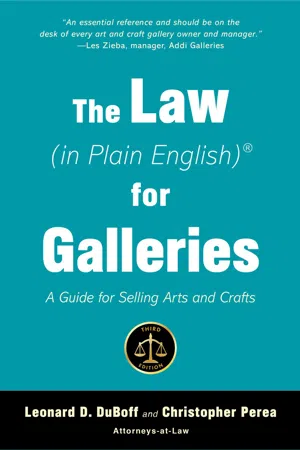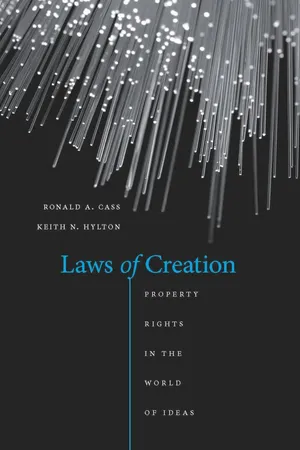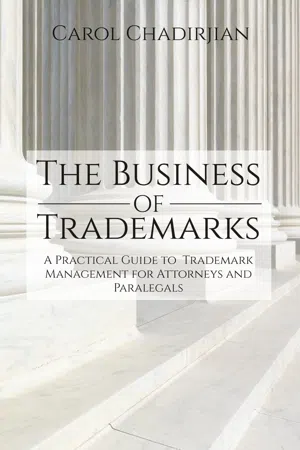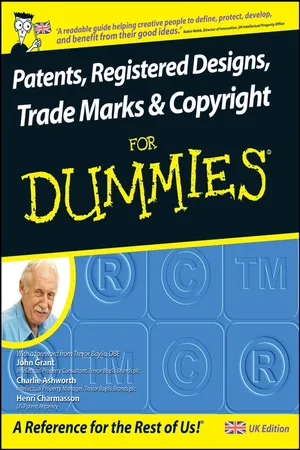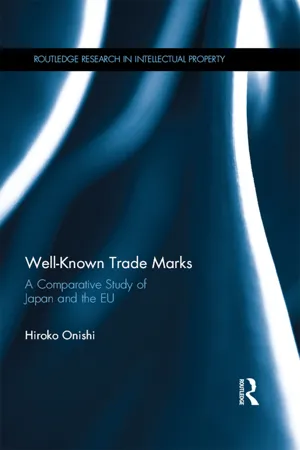Trademark
A trademark is a recognizable sign, design, or expression that distinguishes products or services of a particular source from those of others. It can be a word, phrase, symbol, or design, and is legally registered to protect the owner's exclusive rights to use it in commerce. Trademarks help consumers identify and choose products or services based on their quality and reputation.
8 Key excerpts on "Trademark"
- eBook - ePub
The Law (in Plain English) for Galleries
A Guide for Selling Arts and Crafts
- Leonard D. DuBoff, Christopher Perea(Authors)
- 2020(Publication Date)
- Allworth(Publisher)
...Trademarks still function primarily as a means of identifying the source of a particular product. Trademark laws are also designed to enable the Trademark proprietor to develop goodwill for the product as well as to prevent another party from exploiting that goodwill—regardless of whether that exploitation is intentional or innocent. DEFINITION A simplification of the federal definition of a Trademark is— any word, name, symbol, device, or any combination thereof, adopted and used by a person, or which a person has a bona fide intention to use in commerce and subsequently does use, which identifies and distinguishes his or her goods or services, including a unique product, from those manufactured or sold by others, and indicates the source of those goods or services, even if that source is unknown. A Trademark owner may be a licensee, broker, or distributor. The term, use in commerce, means the bona fide use of a mark in the ordinary course of trade—not a use made merely to reserve a right in the mark. Reservation of a mark prior to its use can be achieved by filing an intent-to-use application with the Patent and Trademark Office (PTO). The key concept of Trademark law is that the Trademark must be distinguishable. In order to secure Trademark protection, one must develop a distinctive mark. The most distinctive Trademarks are those that are purely arbitrary or fanciful (i.e., those that have no meaning or connotation other than identifying the source of a particular product). For example, the Trademark “Kroma” to identify dichroic glass jewelry is purely fanciful. Less distinctive are Trademarks that have another meaning, such as the Trademark Shell to identify gasoline...
- eBook - ePub
Intellectual Property Management
A Guide for Scientists, Engineers, Financiers, and Managers
- Claas Junghans, Adam Levy(Authors)
- 2015(Publication Date)
- Wiley-VCH(Publisher)
...All kinds of signs can be protected as a Trademark, particularly words and names of people, illustrations, letters, figures, sound marks, 3-dimensional designs, including the shape of a product (3-dimensional Trademarks) or their packaging as well as any other make-ups including colours and colour combinations. The combination of words and pictures, regardless of whether they are in colour or not, can also be protected. Examples of Trademarks are: Combinations of letters and digits, e.g. BBC, CNN, Levi-501s, 7-ELEVEN. Advertising slogans or short successions of words, e.g. SLIM FAST. Short successions of musical notes known as jingles, e.g. Intel inside tune. Colours, e.g. magenta for Deutsche Telekom, blue/silver/red for Red Bull. Objects, e.g. the COCA COLA bottle. The special function of a Trademark is to designate the origin or maker of a product. The Trademark is not to be used to indicate the product itself. For this reason, the Trademark offices check whether the labelling to be registered possibly concerns names that describe the content of the product or service. The Trademark may not be a synonym for the product or the service itself. The registration of the Trademark “fruit” is not, for example, possible for identifying a greengrocery. A Trademark is usually in force for 10 years and can be extended, usually in increments of 10 years, for an indefinite period. Trademarks that have been in use for many years can acquire significant value. They belong to the company’s property and form part of the insolvency proceedings in case of bankruptcy. A Trademark can be licensed exclusively or non-exclusively for all goods and services for which the Trademark is registered, or for only a subset of these. In this, it enjoys an advantage over other rights such as company or subsidiary names that may only be transferred along with the corresponding part of the business. The complete or partial transfer is also possible...
- eBook - ePub
- Ronald A. Cass, Keith N. Hylton(Authors)
- 2013(Publication Date)
- Harvard University Press(Publisher)
...This is a far more serious issue than safeguarding silly names. Trademark law is surprisingly complicated and full of details. It is not our goal in this chapter to explore all of those details, for there are so many that only a well-paid Trademark lawyer would have the motivation and patience to explain them. At bottom, the law confronts the same trade-offs between the costs of monopolizing markets (static costs) and the benefits of market-expanding innovation (dynamic benefits) examined in the previous chapters. 1 Trademark doctrine strikes a defensible balance between these costs and benefits. In the course of applying our framework to Trademark law, we hope to clarify the relationship between Trademark and efficient markets, a topic that has led to a chorus of scholarly critiques of Trademark. 2 Competition for marks is a lot like competition for location, since a good brand name can help attract consumers while a bad brand name will not help or may actually turn consumers away. As we explain below, there is no reason to believe that unregulated competition for brand differentiation and related brand names will lead to the best possible outcome. Trademark law, rather than assisting firms in their effort to establish an optimal set of property rights, actually seeks to correct some well-known types of market failure. This is the perspective from which Trademark law should be viewed. The Functions of Trademark It is overly simplistic to refer to a Trademark, as we did at the outset, as nothing more than a label. The Trademark is a label identifying the source of the product, but it is more fundamentally a signal. As a signal, the Trademark serves several functions. The functions of the Trademark signal can be grouped into two broad categories consistent with our general approach: (1) supporting market-expanding investments, and (2) gaining some degree of power over price in the market...
- eBook - ePub
- Teresa da Silva Lopes, Paul Duguid(Authors)
- 2010(Publication Date)
- Routledge(Publisher)
...It then goes on to explore the seeming antithesis between Trademarks’ procompetitive nature on the one hand, and the exclusionary scope and monopolistic effect of Trademark rights on the other. It does so by focussing on two areas of Trademark law that exemplify this contrast: comparative advertising and functionality. In doing so, the chapter refers to Trademark law both in the European Union, where it is governed by the Trade Mark Directive, and in the United States. TrademarkS AND BRANDS In order to understand how a Trademark may act as a barrier to market entry, it is first necessary to examine the relationship between a Trademark and brand. Despite the value placed upon successful brands, there is no generally accepted definition of a brand, as such. However, the literature relating to brands (rather than Trademarks) does identify a number of attributes that are likely to be ascribed to a brand. For example, according to the International Trademark Association (INTA): A brand is a trade mark (or combination of trade marks) that, through promotion and use, has acquired a significance over and above its functional use by a company to distinguish its goods or services from those of other traders. 5 This is a very narrow definition of a brand, and not one that would be recognizable to those involved in brand development. At the other extreme, L. D. Chernatony and F. D. Riley identify nine aspects of a brand. Thus a brand is: 1. a legal instrument, 2. a differentiating device, 3. a company, 4. an identity system, 5. an image in consumers’ minds, 6. a personality, 7. a relationship, 8. adding value, and 9. an evolving entity. 6 In fact, although markedly different, both these approaches view registered Trademark(s) as an essential attribute of a brand. However, the latter approach also suggests, as do most definitions of a brand, that a brand’s value extends beyond the value of the product with which it is associated...
- eBook - ePub
Brands
The Logos of the Global Economy
- Celia Lury(Author)
- 2004(Publication Date)
- Routledge(Publisher)
...In this respect, the law makes a specific contribution to the objectivity of the brand—that is, to the operation of the brand as a new market modality or cultural form. It will be suggested that the law is one of the most significant actors in the organisation of the asymmetry of the relations between producers and consumers, operating so as to consolidate and legitimate the use of the brand as an object or mode of capital accumulation. Trade mark: its definition and purpose As is widely known, the signs that comprise logos may be legally recognised as trade marks, a type of intellectual property, the law relating to which is currently governed in the United Kingdom by the Trade Marks Act 1994 (TMA 1994). The earliest trade marks recognized by statute law in England were the hallmarks used by the cutlers of Hallamshire, Sheffield. Regulations regarding the use of such hallmarks were first drawn up during the reign of Elizabeth I and codified by the Cutler’s Company Act of 1623. It was not until 1875, however, that the first British Trade Marks Act was passed. The first mark registered under the Act was the red triangle for Bass pale ale, and since then over 2 million marks have been registered (with 400,000 still in force). The 1875 Act has been amended several times, notably in 1938 and again in 1986, when the provision of statutory protection was extended to owners of service marks. The 1994 Act defines a trade mark as ‘any sign capable of being represented graphically which is capable of distinguishing the goods or services of one undertaking from those of other undertakings’ (s. 1(1)). This legal statement can be broken down into three components. First, the legal object of a registered trade mark is a sign. As such, it may include logos such as the word ‘Nike’ or the ‘swoosh’ with which the Nike corporation marks its goods. Many brands make use of a number of trade marks...
- eBook - ePub
The Business of Trademarks
A Practical Guide to Trademark Management for Attorneys and Paralegals
- Carol Chadirjian(Author)
- 2018(Publication Date)
- Universal-Publishers(Publisher)
...Chapter Two Trademarks as a form of Intellectual Property Trademark’s Relationship to Other Forms of Intellectual Property Intellectual property is defined by the Convention Establishing the World Intellectual Property Organization (WIPO), Stockholm on July 14, 1967 (Article 2 (viii)) as: literary, artistic and scientific works performances of performing artists, phonograms and broadcasts inventions in all fields of human endeavor scientific discoveries industrial designs Trademarks, service marks and commercial names and designations protection against unfair competition There is much confusion about difference between the types of intellectual property. Intellectual property consists of Trademarks, patents, and copyrights which are intangible assets to the company that owns it. During corporate transactions, intellectual property plays a significant part as being a valuable corporate asset. The chart differentiates between patents, Trademarks, and copyrights: A patent grants the owner a time-limited monopoly over new and original inventions, processes, or designs, or new and original updates to existing inventions, processes, or designs. There are design patents, plant patents, and utility patents. While designs may be protectable both as patents and Trademarks, only patent law protects the useful or utilitarian function of an invention, while Trademark law protects the nonfunctional and distinctive elements. The existence of a utility patent on a Trademark indicates that it is not registrable. Copyrights protect creative and original literary works, artwork, and music. Copyrights protect the creator’s rights for a certain period. The Creator has the right to protection of the copyright, whether a copyright application is filed or not. Copyright sometimes overlaps with Trademark rights...
- John Grant, Charlie Ashworth, Henri J. A. Charmasson(Authors)
- 2011(Publication Date)
- For Dummies(Publisher)
...Part IV Making Your Mark: Protecting Your Brand Identity In this part. . . S ure, you’re probably familiar with that little TM trade mark symbol. But did you know that several other types of marks, including trade names, product names, logos, and service marks are just sitting there waiting for you to put them into the game as well? All these marks have a common purpose – to put an exclusive (and hopefully favourable) brand on your goods and services, giving you an edge over your competition. We devote this part to helping you to understand which marks warrant trade mark protection, and how to go about ensuring that you protect your brand. We also demonstrate (with plenty of examples) what makes an effective mark and what types you should avoid. And after you decide to draft one or more trade marks such as names or logos, you still need to make sure that they’re the best pick. We lay out a game plan that walks you through the search for look-alikes (and sound-alikes) and outline how to register and use your trade mark or service mark. Chapter 14 Solving Your Identity Crisis In This Chapter Understanding the roles and functions of trade marks Making the most of your trade name or trade mark Appraising the weight of a trade mark Striving for exclusive rights by using a distinctive brand identity A trade mark, such as your company name, the brand on your product, or the catchy tagline from your marketing campaign, is a goodwill ambassador, a herald, a promise – your trade mark is the first thing a customer sees or hears about your firm or your product. This first contact often determines the customer’s attitude towards your business or product. Your trade marks are your prime marketing tools and help your potential customers choose between a range of similar products and services. When you start a new business or introduce a new product or service, you have a chance to create value out of nothing...
- eBook - ePub
Well-Known Trade Marks
A Comparative Study of Japan and the EU
- Hiroko Onishi(Author)
- 2015(Publication Date)
- Routledge(Publisher)
...The relevant Article in full is: Article 15(1) any signs, or any combination of signs, capable of distinguishing the goods or services of one undertaking from those of other undertakings, shall be capable of constituting a Trademark. Such signs, in particular words including personal names, letters, numerals, figurative elements and combinations of colours as well as any combinations of such signs, shall be eligible for registration as Trademarks. Where signs are not inherently capable of distinguishing the relevant goods or service, members may make registrability depend on distinctiveness acquired through use. Member may require, as a condition of registration, that signs be visually perceptible. [Emphasis added] As can be seen in the extract above, attention is given to both form and concept (albeit in a slightly different manner from that used by the other international instruments 87), and it stands out on its own in defining the scope of registered trade marks 88 in a fuller sense. What is more, GATT TRIPS provides a treatment to the preconditions of the Definition Model (see the explicit reference to visual perception (graphic representation)). 89 Returning to other aspects of the Definition Model, the following can be noted: within trade mark form, trade mark context can be seen to include trade marks 90 and service marks; 91 geographical indication might also be included herein. 92 Also within trade mark form, trade mark type includes signs, words, personal names, letters, numbers and figurative marks, combination of colours and combination of signs. 93 The scope of form type thus appears to be sufficiently flexible to include non-traditional trade marks such as scents, as well as the more traditional trade mark examples explicitly listed. The concept of ‘trade mark’ within the Definition Model is noted in the phrase ‘signs, which are capable of distinguishing ’...
